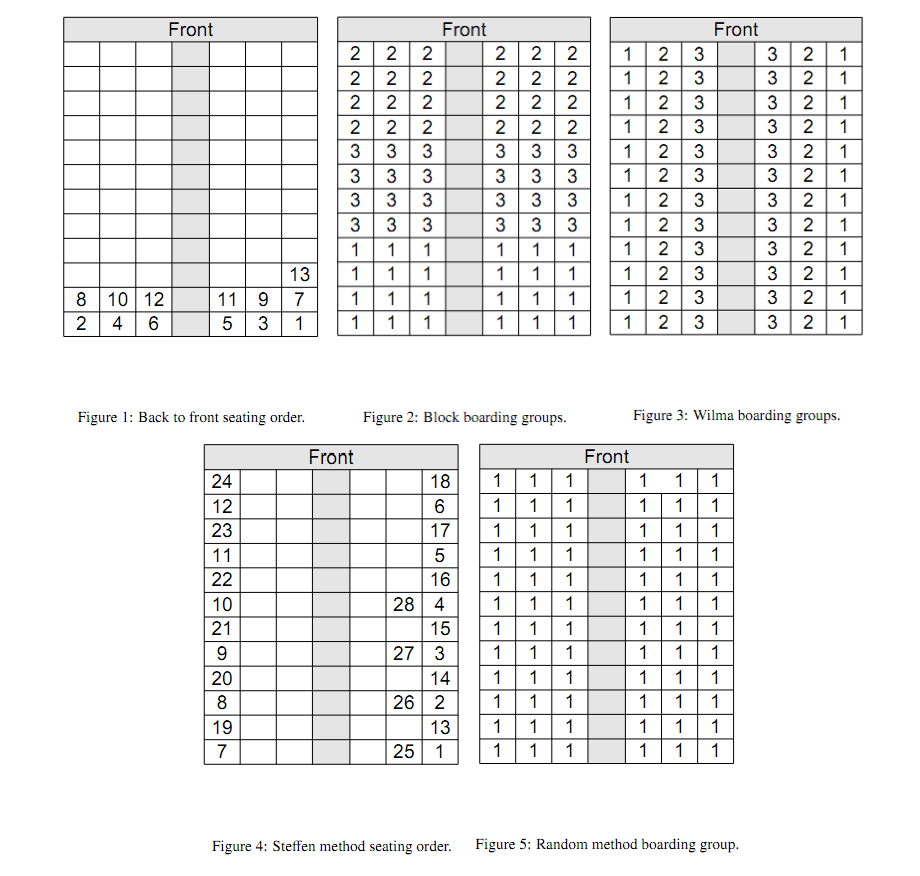• Title: Experimental test of airplane boarding methods
• Authors: John H. Steffen, Jon Hitchkiss
• First Author’s Institution: Fermilab Center for Particle Astrophysics
Today’s astrobite doesn’t have much to do with astronomy. In fact, at yesterday’s morning coffee discussion here at UCSC, there was a bit of surprise that this particular paper was cross-listed to the astrophysics section of arxiv.org at all. I guess the authors know that astronomers tend to spend an unusually large fraction of their lives in airplane cabins, so it would be worthwhile to notify us of the latest developments in the science of air travel.
The question this paper would like to answer is a deceptively simple one: what is the optimal way to board an airplane? As the answer to this particular question can save airlines money, a significant amount of effort has already been expended on computational models of airplane boarding. In 2008, the lead author of this study published a candidate for the holy grail of the field: the optimum boarding strategy. Here, the authors experimentally verify whether the boarding procedure worked out by Steffen in 2008 is truly the optimum boarding strategy.
There are two types of inefficiency in airplane boarding. The first, called aisle interference, happens when passengers stop in the aisle to put away their luggage. The second, called seat interference, happens when a passenger has to wait for another passenger in their row to sit down before they can enter the row. Seat interferences don’t necessarily impact boarding time, but they can cause aisle interferences, which do increase boarding time. Different boarding methods entail different tradeoffs between the number of seat and aisle interferences. The optimal boarding strategy is such that the total time to board is minimized because of an efficient distribution of aisle and seat interferences.
Using a mock 757 cabin, complete with standard airline seats and overheard bins, the authors asked a group of volunteers to board the cabin according to several different boarding algorithms. The group of passengers included children and seniors, but mostly consisted of employment-age adults. Most passengers had a piece or two of luggage, enough so that the overhead bins were completely full when the plane finished boarding.
The authors test five different boarding methods. The first method had the passengers line up by seat assignment, from the back to the front. This maximizes the number of aisle interferences. The second method, employed by the majority of airlines today, was block boarding, where passengers board in groups based on the position of their seat in the plane. The third method, the so-called Wilma boarding method, had all of the passengers in window seats board first, then passengers in center seats, then aisle seats. This method eliminates seat interferences by construction. Next, the Steffen method, like the Wilma method, has passengers in window seats board first, followed by center seats, then aisle seats. However, it does so in a staggered fashion in an effort to avoid aisle interferences. The last method had the passengers line up in a completely random order, board, and find assigned seats. This is distinct from the free-for-all method employed by Southwest Airlines, since passengers must find their assigned seats rather than picking a seat while boarding.
In the end, the authors find that the most efficient boarding method is indeed the Steffen method, allowing the passengers to board in about three and a half minutes. The Wilma method comes in as a close second, allowing boarding in about 4 minutes and 15 seconds. Random boarding does just a little bit worse than Wilma, allowing boarding to finish in 4 minutes, 45 seconds. Block boarding and back-to-front do the worst by far, both finish boarding after more than 6 minutes has elapsed.
One interesting result was the block boarding fared significantly worse than randomly boarding the whole plane. The authors suggest that this is because block boarding is effectively the same as boarding three smaller planes of four aisles each. This increases the probability of a seat interference leading to an aisle interference because there is more of a chance that the next passenger is sitting in the same area as the seat interference. Block boarding is thus intrinsically less efficient than random boarding – although the authors expect that as the size of the block increases the difference between random and block boarding becomes less significant.
While the most efficient boarding schemes do reduce boarding time significantly, they probably can’t work in practice due to sociological factors. A Steffen boarding scheme entails breaking up families during the boarding process – a prospect parents with young children would surely object to. The fact that random boarding does so much better than block boarding suggests that there might be a way to easily increase the efficiency of airplane boarding – simply go with random boarding instead of block boarding!


Trackbacks/Pingbacks